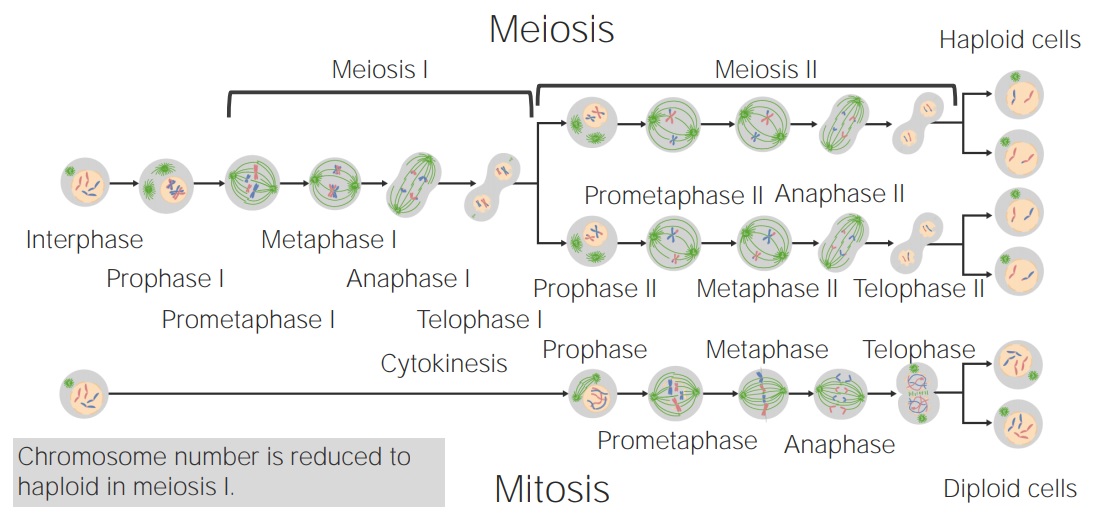Playlist
Show Playlist
Hide Playlist
Introduction and Reduce of Chromosomes – Meiosis
-
Slides 13 Meiosis CellBiology.pdf
-
Reference List Molecular and Cell Biology.pdf
-
Download Lecture Overview
00:01 Zuvor haben wir uns mit der Zellteilung beschäftigt und die Mitose betrachtet. Jetzt wollen wir uns die Meiose der Zellteilung ansehen. 00:07 Die Meiose dient der sexuellen Fortpflanzung bei Eukaryoten. Am Ende dieser Vorlesung, sollten Sie in der Lage sein, sich sicher mit den Vokabeln der Chromosomen zu fühlen. Es ist besonders wichtig, wenn wir die Meiose mit der Mitose vergleichen. Wir werden werden auch in der Lage sein, die Unterscheidungsmerkmale der Meiose zu erkennen. Was unterscheidet sie speziell von der Mitose? Einer der wichtigsten Faktoren der sexuellen Fortpflanzung ist, dass wir eine gewisse genetische Variation erhalten können, die auf die evolutionäre Mechanismen einwirken kann. 00:48 Als nächstes können wir die Meiose mit der Gametenbildung in Beziehung setzen. Verstehen, wie sie mit der Produktion von Spermien und Eizellen zusammenhängt. 00:56 Außerdem werden Sie in der Lage sein zwischen Mitose, Meiose I und Meiose II unterscheiden und einiger dieser Unterscheidungsmerkmale definieren zu können. Also, lassen Sie uns damit beginnen, darüber nachzudenken, warum wir Meiose überhaupt brauchen. Wir Menschen haben 46 Chromosomen. 23 Paare und jedes dieser Chromosomenpaare muss sich trennen, um haploide Keimzellen und Spermien zu bilden. Wir sind also diploid. Unsere Keimzellen, Spermien und Eierzellen, sind haploid. Jedes von ihnen muss also 23 Chromosomen haben. Eines von jeder Kopie. 01:42 Diploide Organismen haben also jeweils ein Paar Chromosomen. Haploide Organismen haben einen haploiden Satz von jedem dieser Chromosomen. Die Keimbahnzellen sind also die Zellen, die zu Spermien und Eizellen werden. 02:01 Die Keimbahnzellen selbst sind also eigentlich diploid. Und Spermien und Eizellen werden haploid, nachdem der Prozess der Meiose. Die sexuelle Fortpflanzung führt dazu, dass das Spermien und das Ei sich gegenseitig befruchten. 02:15 Und wieder zu einem diploiden Zustand in der der Zygote werden. Wir haben also eine diploide Zygote, die sich entwickeln wird und bei der die Zellteilung stattfinden wird. Und hier kommen die Zellzykluskontrollen ins Spiel. Schauen wir uns nun die 'Sprache der Chromosomen' an. Dies ist besonders wichtig für uns bevor wir verstehen können, was in der Meiose vor sich geht. Noch wichtiger als das Wissen, das während der Prophase, Metaphase, Anaphase usw passiert, ist, daß wir verstehen was mit den Chromosomen passiert. Also, am besten ist es in einem Diagramm darzustellen und nicht nur die einzelnen Phasen zu beschreiben. Lassen Sie uns also einen kurzen Blick darauf werfen. 03:03 Erinnern wir uns zunächst daran, dass wir jeweils zwei Kopien eines jedes Chromosoms haben. Während der S-Phase werden diese Chromosomen repliziert. Jedes Chromosom hat also eine Kopie von sich selbst. Eine davon stammt ursprünglich von dem Vater und eine stammt ursprünglich von der Mutter. Und dann, während des Meioseprozesses, werden die homologen Chromosomen, die repliziert werden, getrennt und die Schwesterchromatiden werden die Meiose II. 03:41 Wenn man also die Chromosomen-Sprache betrachtet, sind homologe Chromosomen zwei von der gleichen Art. Sobald sie eine Replikation während der S-Phase durchlaufen haben, können diese homologen Chromosomen als replizierte homologe Chromosomen bezeichnet werden, da sie jeweils eine identische Kopie haben. Nun, erinnern Sie sich dass es eine kleine Einbuchtung einer dicht gepackte DNA-Region gibt, die wir das Zentromer nennen. Das Zentromer hat einige Kinetochor, die wie Griffe auf den Chromosomen wirken. 04:13 Diese Kinetochor-Griffe werden in der Zelle benutzt um die Bewegung von Chromosomen während der Zellteilung zu unterstützen – um den Zellkern zu den Schwesterchromatiden oder homologe Paare auseinander zu ziehen. 04:26 Ab hier werden wir uns also ansehen, wie diese Zellteilung von statten geht. Wann reduzieren wir eigentlich die Chromosomenzahl? Das ist eine Frage, die man im Kopf behalten halten sollte. Die Meiose hat zwei Kernteilungen und nur eine DNA-Replikation. Also durchlaufen die Keimbahnzellen den Zellzyklus immer und immer wieder und produzieren immer mehr Keimbahnzellen. Sie wissen, dass sie vielleicht eine Meiose durchlaufen können und zu Spermien und Eizellen werden können. Aber sie durchlaufen die Mitose bis sie reif sind. Zu einem bestimmten Zeitpunkt, wird es eine Art von Zellsignal geben, das den Keimbahnzellen mitteilt, dass sie diploid sind und das es für sie an der Zeit ist, sich in vier Gametenzellen zu teilen. Und das ist der Punkt, den wir uns jetzt noch genauer ansehen werden. 05:22 In der Meiose I findet also die Reduktionsteilung statt. Ich werde das einige Male wiederholen, da es wirklich wichtig ist zu erkennen, dass das der Übergang von diploid zu haploid ist. 05:35 Nach der Meiose I haben wir in jeder entstehenden Zelle eine Kopie jedes unserer Chromosomen. 05:44 Also entweder landet aus der Meiose I in einer der entstehenden Zellen das Chromosom der Mutter oder das des Vaters. 05:51 Während der Meiose II, nehmen wir diese getrennten homologen Chromosomen und spalten die Schwesterchromatiden, so dass jede der entstehenden Zelle eine Kopie des Chromosoms hat. 06:06 Bei der Meiose I haben wir also unsere homologen Chromosomen. Sie trennen sich. Und in Meiose II trennen sich die Schwesterchromatiden. 06:16 Hier ist die Sprache also besonders wichtig wird.
About the Lecture
The lecture Introduction and Reduce of Chromosomes – Meiosis by Georgina Cornwall, PhD is from the course Cell Cycle and Cell Division.
Included Quiz Questions
Which of the following is true about germline cells before meiosis?
- They are diploid.
- They are haploid.
- They are polyploid.
- They are triploid.
- They are tetraploid.
Which of the following best describes meiosis?
- Two nuclear divisions with one round of DNA synthesis
- Four nuclear divisions with one round of DNA synthesis
- Two nuclear divisions with two rounds of DNA synthesis
- Four nuclear divisions with two rounds of DNA synthesis
- Four nuclear divisions with four rounds of DNA synthesis
Which of the following is NOT correct regarding meiosis?
- The human sperm and egg contain 23 and 46 pairs of chromosomes, respectively.
- Meiosis is a reductional division in which the chromosome number in gametes is reduced to half of that in the parent cell.
- Meiosis plays an important role in the sexual reproduction of eukaryotic organisms.
- Meiosis-I involves the segregation of homologous chromosomes, whereas meiosis-II involves the separation of sister chromatids.
- Separation of cohesin proteins is integral to both mitosis and meiosis-II.
Customer reviews
5,0 of 5 stars
| 5 Stars |
|
5 |
| 4 Stars |
|
0 |
| 3 Stars |
|
0 |
| 2 Stars |
|
0 |
| 1 Star |
|
0 |




